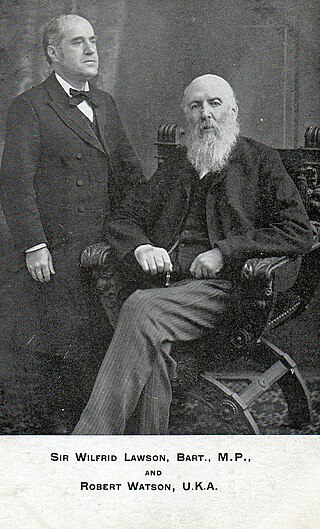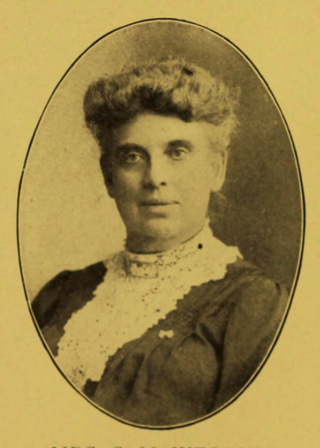
The temperance movement is a social movement promoting temperance or complete abstinence from consumption of alcoholic beverages. Participants in the movement typically criticize alcohol intoxication or promote teetotalism, and its leaders emphasize alcohol's negative effects on people's health, personalities and family lives. Typically the movement promotes alcohol education and it also demands the passage of new laws against the sale of alcohol, either regulations on the availability of alcohol, or the complete prohibition of it.
The Woman's Christian Temperance Union (WCTU) is an international temperance organization. It was among the first organizations of women devoted to social reform with a program that "linked the religious and the secular through concerted and far-reaching reform strategies based on applied Christianity." It plays an influential role in the temperance movement. Originating among women in the United States Prohibition movement, the organization supported the 18th Amendment and was also influential in social reform issues that came to prominence in the progressive era.

Theobald Mathew was an Irish Catholic priest and teetotalist reformer, popularly known as Father Mathew. He was born at Thomastown, near Golden, County Tipperary, on 10 October 1790, to James Mathew and his wife Anne, daughter of George Whyte, of Cappaghwhyte. Of the family of the Earls Landaff, he was a kinsman of the clergyman Arnold Mathew.
The Lincoln–Lee Legion was established by Anti-Saloon League-founder Howard Hyde Russell in 1903 to promote the signing of abstinence pledges by children. The organization was originally called the Lincoln League, named after Abraham Lincoln. However, in 1912 it was renamed the Lincoln–Lee Legion, adding a reference to Robert E. Lee in order to make it more appealing to southern children and their parents.

The United Kingdom Alliance (UKA) was a temperance movement in the United Kingdom founded in 1853 in Manchester to work for the prohibition of the trade in alcohol in the United Kingdom. This occurred in a context of support for the type of law passed by General Neal Dow in Maine, United States, in 1851, prohibiting the sale of intoxicants.

The Catholic Total Abstinence Union of America was a Roman Catholic temperance organization active in the 19th and 20th centuries. The work of Father Mathew in promoting temperance across the U.S. led to the establishment of numerous separate and independent Catholic temperance groups. The Catholic temperance societies of Connecticut created a state union in 1871, from which a national union was formed the following year at a convention in Baltimore, Maryland. 177 such societies from 10 states and the District of Columbia, representing a total of 26,481 members, created the Catholic Total Abstinence Union of America. In total, over 500,000 Roman Catholics made the temperance of the Catholic Total Abstinence Union of America.

Margaret Bright Lucas was a British temperance activist and suffragist. She served as president of the British Women's Temperance Association (BWTA), the World's Woman's Christian Temperance Union (WCTU), and the Bloomsbury branch of the Women's Liberal Association.
James Wentworth Leigh was an Anglican priest in the last decade of the 19th century and the first two of the 20th. He was a very active Freemason, an enthusiastic temperance campaigner, and an ardent social reformer.

Annie Jane Schnackenberg was a New Zealand Wesleyan missionary, temperance and welfare worker, and suffragist. She served as president of the Auckland branch of the Women's Christian Temperance Union New Zealand 1887 to 1897, and national president for WCTU NZ from 1892 to 1901 – overseeing the final push for petitioning the government to grant women the right to vote in national elections. She also was a charter member of the National Council of Women of New Zealand.

In the United States, the temperance movement, which sought to curb the consumption of alcohol, had a large influence on American politics and American society in the nineteenth and twentieth centuries, culminating in the prohibition of alcohol, through the Eighteenth Amendment to the United States Constitution, from 1920 to 1933. Today, there are organizations that continue to promote the cause of temperance.
The temperance movement in the United Kingdom was a social movement that campaigned against the recreational use and sale of alcohol, and promoted total abstinence (teetotalism). In the 19th century, high levels of alcohol consumption and drunkenness were seen by social reformers as a danger to society's wellbeing, leading to social issues such as poverty, child neglect, immorality and economic decline. Temperance societies began to be formed in the 1830s to campaign against alcohol. Specific groups were created over periods of time dedicated to the different aspects of drinking. For example, in 1847, the Band of Hope was created to persuade children not to start drinking alcohol. Most of these temperance groups were aimed at the working class. Temperance was also supported by some religious groups, particularly the Nonconformist Churches. Although the temperance movement met with local success in parts of Britain, it failed to impose national prohibition, and disappeared as a significant force following the Second World War.

Catholic involvement in the temperance movement has been very strong since at least the nineteenth century, with a number of specifically Catholic societies formed to encourage moderation or total abstinence from alcohol.

Edward Long Fox was an English physician.
Adam's ale is a colloquial allusion meaning water. It alludes to the idea that the biblical Adam had only water to drink. This inference gained popularity around the beginning of the 19th-century temperance movement.

Teetotalism is the practice or promotion of total personal abstinence from the consumption of alcohol, specifically in alcoholic drinks. A person who practices teetotalism is called a teetotaler or teetotaller, or is simply said to be teetotal. Globally, almost half of adults do not drink alcohol. A number of temperance organisations have been founded in order to promote teetotalism and provide spaces for non-drinkers to socialise.

Norman Shanks Kerr was a Scottish physician and social reformer who is remembered for his work in the British temperance movement. He originated the Total Abstinence Society and was founder and first president of the Society for the Study and Cure of Inebriety which was founded in 1884.

Women's Christian Temperance Union of New Zealand is a non-partisan, non-denominational, and non-profit organisation that is the oldest continuously active national organisation of women in New Zealand. The national organisation began in 1885 during the visit to New Zealand by Mary Clement Leavitt, the first world missionary for the Woman's Christian Temperance Union. The WCTU NZ was an early branch of the World Woman's Christian Temperance Union and a founding affiliate of the National Council of Women of New Zealand. Men may join the WCTU NZ as honorary members.

Sara Jane Crafts was an American social reformer, author, lecturer, and teacher. She lectured and taught at Chautauquas, as well as a lecturer at State and International Sunday school conventions. Crafts was an editor and contributor to various periodicals, and published several books between 1876 and 1911. Craft was a social reformer who traveled the world advocating on behalf of Sunday schools, temperance, and anti-opium. She was also "one of the first women to conduct convention sessions" in the U.S.
Non-Partisan National Women's Christian Temperance Union was an American temperance association organized at Cleveland, Ohio, January 22, 1890, as a protest against the attitude of the Woman's Christian Temperance Union (W.C.T.U.) toward political parties.
The Ladies' National Temperance Convention of 1876 was a temperance movement women's conference promoted by the National Temperance League. The convening occurred in London, United Kingdom, on 22-24 May 1876, with Lady Jane Harriet Ellice presiding. No permanent organisation was subsequently created.












